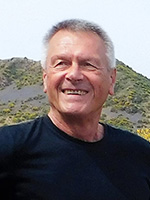Engineering Improved Lung Function: Zoltán Hantos, PhD

Zoltán Hantos, PhD, is a researcher fascinated by the anatomical and functional complexity of organ systems.
While most lung function techniques establish single measures for a whole breath or an average of many breaths, Dr. Hantos’ current approach is to track the intrabreath changes in respiratory mechanics. This method allows him to observe the effects of respiratory volume and airflow on the resistance and elastance of the respiratory system. His team employs a forced oscillation technique (FOT), which is a noninvasive test, performed during normal breathing. It requires minimum cooperation from the subject.
Intrabreath tracking reveals astonishing, previously hidden details of lung mechanics that can be utilized in the early detection of dysfunctions. According to Dr. Hantos, “The FOT is possibly the most sophisticated engineering approach to respiratory mechanics and least interruptive measurement during spontaneous breathing.” However, if performed during reflex apnea in infants, in mechanically ventilated patients, and in the study of animal models of lung disease the technique reveals the most about the lungs’ mechanical function.
Dr. Hantos studied mechanical and electrical engineering in the late ’60s. Eventually, his master’s work was on the electrical modeling of the lymphatic circulation. Soon after he commenced his almost 50 years’ affiliation with the University of Szeged, Hungary, and joined a pulmonary function laboratory in Budapest. There, he helped improve body plethysmography using computing, a technological first.
In retrospect, he says that it was an enormous experience for somebody with a background in biomedical engineering and physiology to develop new tools to help characterize respiratory abnormalities and refine lung function.
He and colleagues are currently developing a new infant lung function technique in Szeged, and longitudinal measurements in a birth cohort study seem promising. The research is being conducted in South Africa, and preliminary data analysis shows that the new descriptors of intrabreath dynamics can predict later events of respiratory disease, such as pneumonia in apparently healthy infants with normal conventional lung function.
Dr. Hantos is proud that his group has been able to contribute to the methodology of pulmonary physiology, especially with limited resources in their Eastern European country. They’ve earned a reputation for excellence, and more importantly, opened a wide network of opportunities. Long-lasting collaborations have formed with respiratory research groups in Australia and the U.S.
“My collaborations with researchers at Boston University and the Harvard School of Public Health made it important—and possible—for me to attend the annual conferences of the ATS since the ’90s,” he says.
Bela Suki, PhD, a professor in biomedical engineering at Boston University had him as an advisor in the mid ’80s. “Zoltán introduced me to the exciting realm of respiratory instrumentation and taught me how to design and carry out experiments to obtain high-quality data. Today he remains one of the best lung physiology experimentalists in the world.”
Dr. Hantos has been the primary investigator on multiple research grants in Hungary and co-investigator on a number of international studies.
His collaborators praise his energy, humor, and expertise. Ron Dandurand, MD, assistant professor, Respiratory Division at McGill University, is one such colleague. “Zoli and I collaborate on an initiative to compare the reproducibility of results between the five commercially marketed oscillometry devices with the participation of all manufacturers and academics in pediatrics, airways pharmacology, veterinary medicine, respiratory physiology, bioengineering, and clinical respirology. Zoli’s longitudinal perspective and depth of knowledge of oscillatory mechanics have been critical to the quality of the data we have gathered so far.”
In addition to the ATS Annual International Conference, Dr. Hantos has been impressed by the sense of community and activities of the Assembly on Respiratory Structure and Function. He considers his time on its program committee a privilege, and one of both inspiration and education.
When not staying up-to-date with the latest research or inspecting past seminal works from brilliant minds like Arthur DuBois, Jere Mead, Peter Macklem, and John West—or unsung heroes like Jack Hildebrandt, Dr. Hantos enjoys biographies. He can also be found dabbling in classical music or sports.

